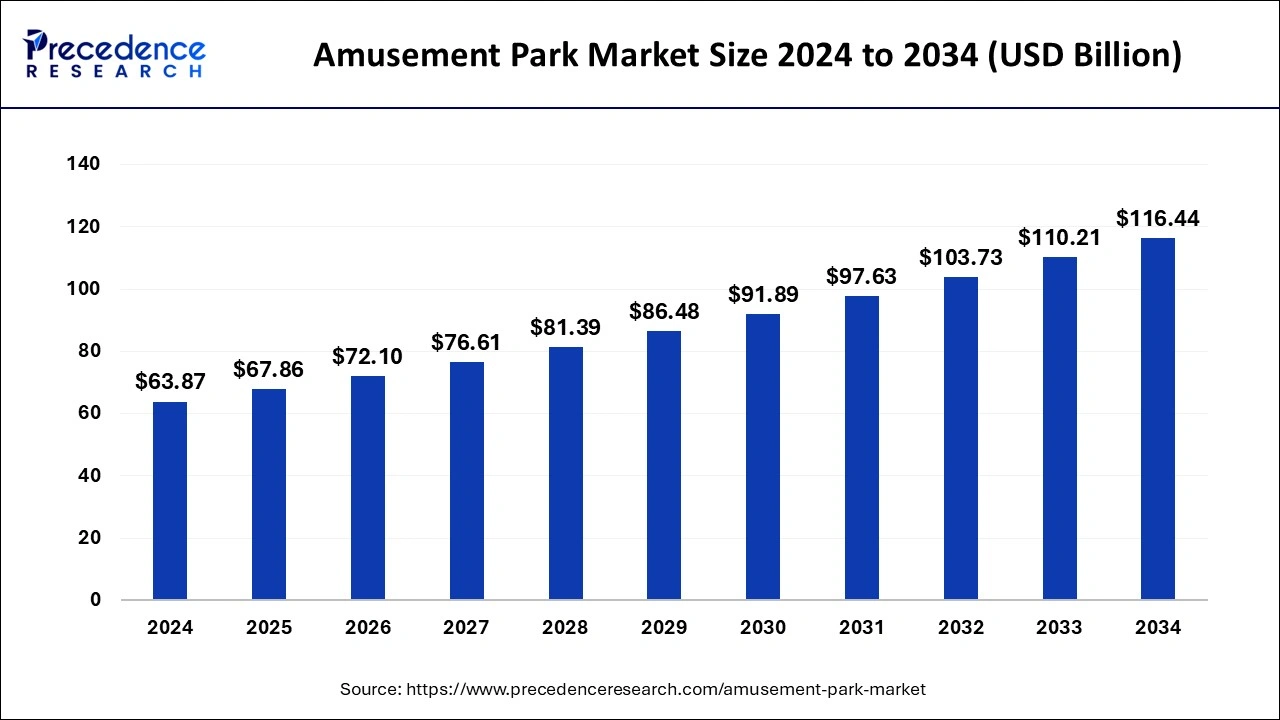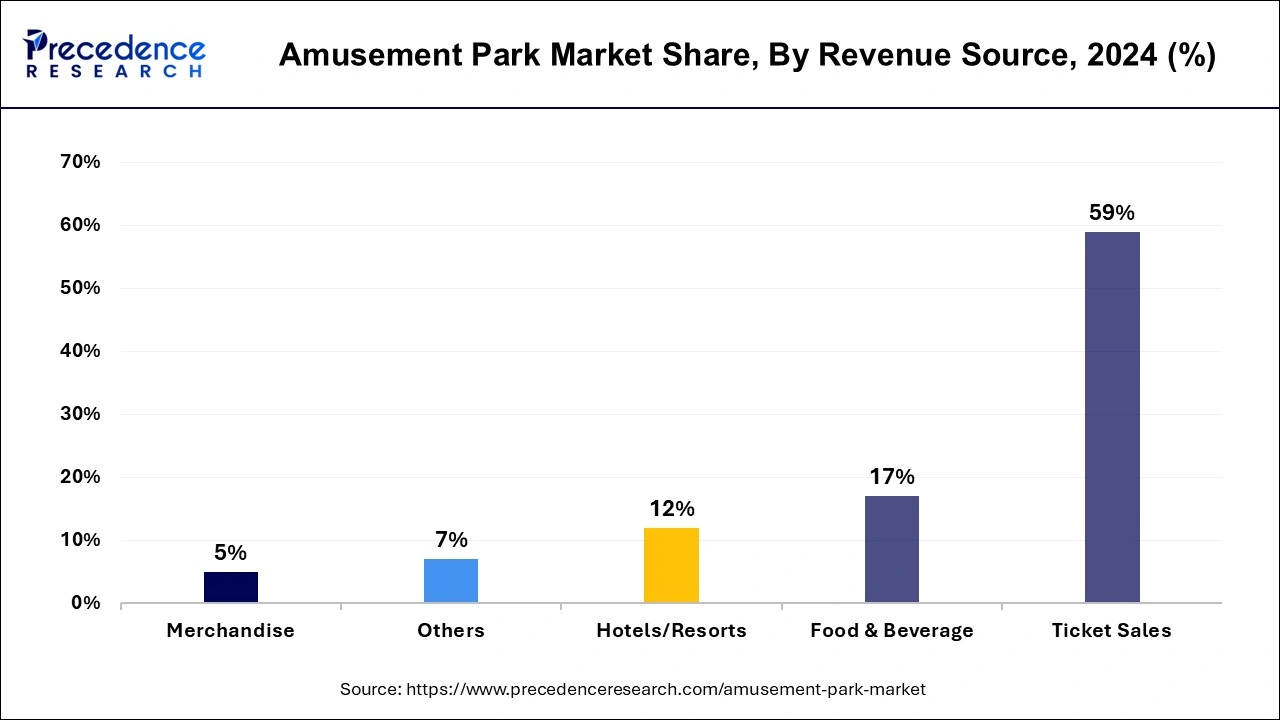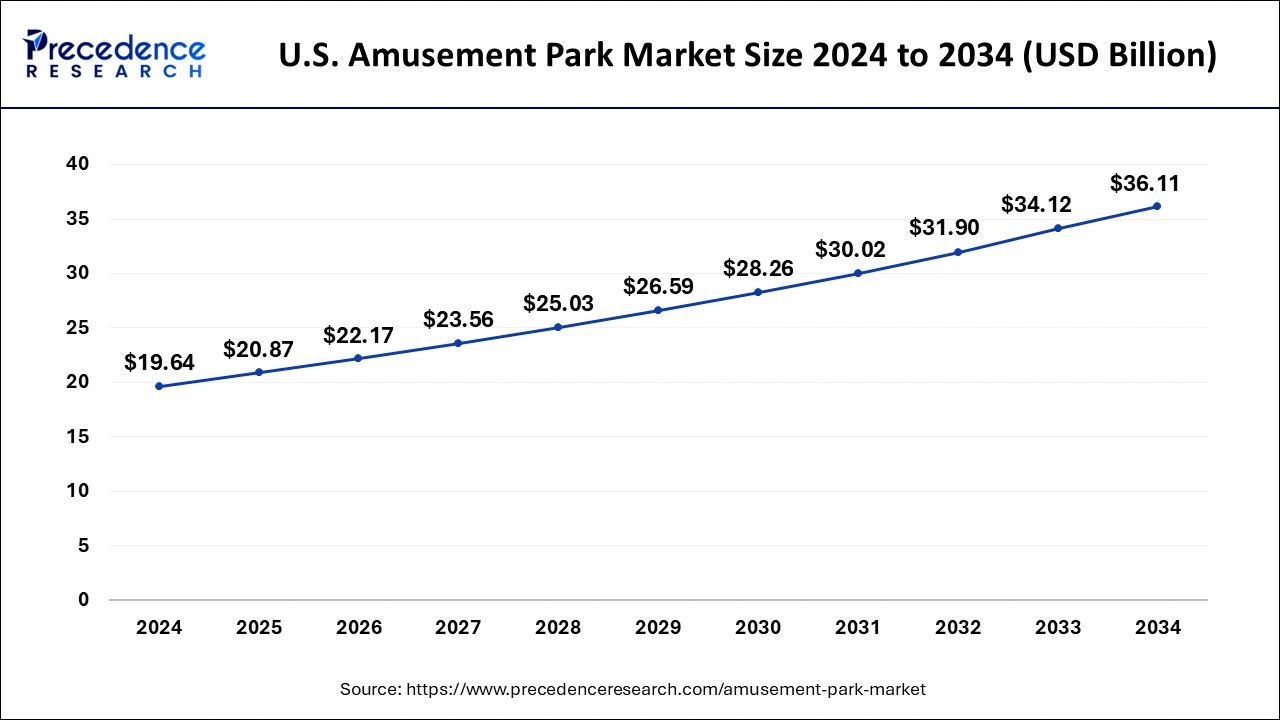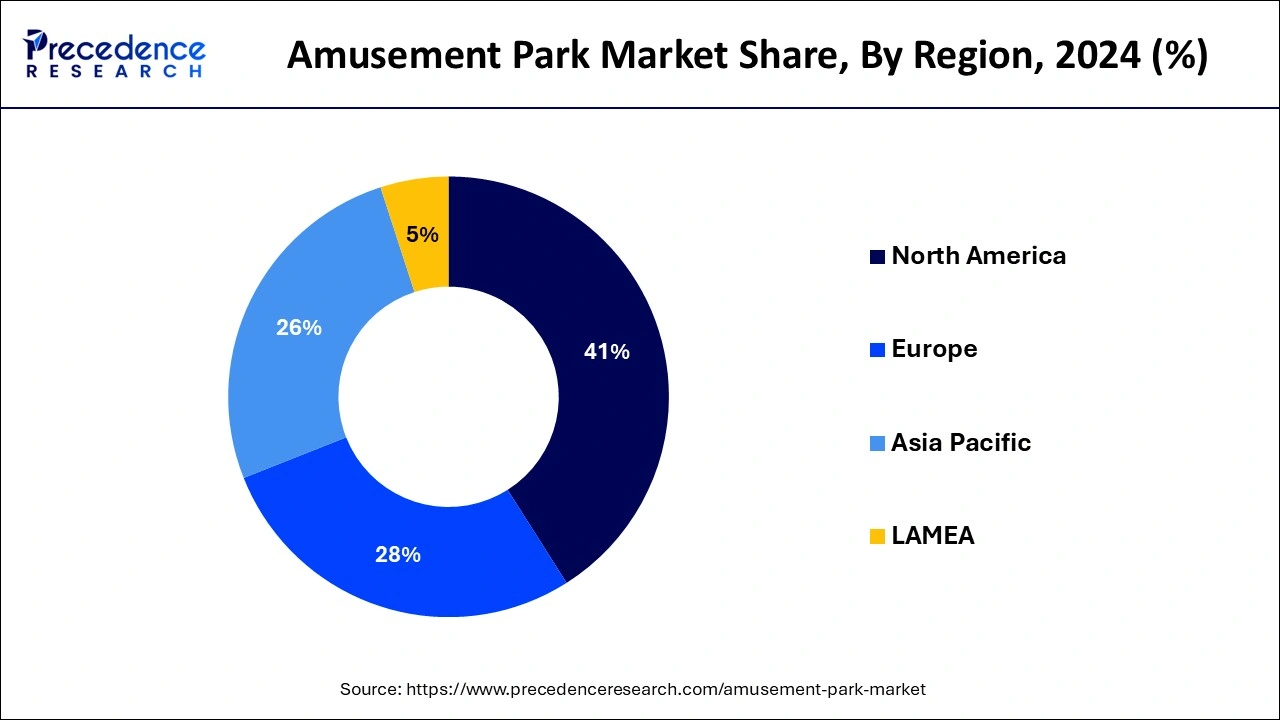What is the Amusement Park Market Size?
The global amusement park market size is estimated at USD 67.86 billion in 2025 and is predicted to increase from USD 72.10 billion in 2026 to approximately USD 116.44 billion by 2034, expanding at a CAGR of 6.19% from 2025 to 2034. The rise in the number of adults and children visiting amusement parks is the key driving factor for the amusement park market.

Market Highlights
- North America dominated the market with the largest market share of 41% in 2024.
- Asia Pacific is anticipated to grow at the fastest CAGR of 9.23% over the study period.
- By rides, the mechanical ride segment has captured the largest market share of 84% in 2024.
- By rides, the water rides segment is expected to expand at the fastest CAGR of 5.32% over the forecast period.
- By age, in 2023, the 19 to 35 years segment has held the biggest market share of 32% in 2024.
- By age, the 36 to 50 years segment is expected to grow at a substantial rate during the projected period.
- By revenue share, the ticket segment has accounted more than 59% of market share in 2024.
- By revenue share, the hotel/resort segment is expected to show fast-paced growth during the projected period.
Market Size and Forecast
- Market Size in 2025: USD 67.86 Billion
- Market Size in 2026: USD 72.10 Billion
- Forecasted Market Size by 2034: USD 116.44 Billion
- CAGR (2025-2034): 6.19%
- Largest Market in 2024: North America
- Fastest Growing Market: Asia Pacific
Market Overview
Amusement parks, characterized by a variety of entertainment attractions like rides and games, offer fun experiences for visitors of all ages. A subset of amusement parks, known as theme parks, revolve around specific themes and feature themed areas with corresponding attractions. Unlike temporary funfairs and carnivals, amusement parks are permanent structures built for ongoing operation. They provide a wide range of attractions catering to diverse age groups and are more extensive than traditional city parks. One key factor driving the amusement park market's positive outlook is the rapid pace of urbanization, accompanied by significant growth in the travel and tourism industry. Moreover, the presence of state-of-the-art rides, licensed merchandise, and accommodation options within theme parks is further fueling the expansion of the industry.
Amusement Park Market Growth Factors
- Expansion of the tourism industry can drive the growth of the amusement park market.
- New and innovative rides are attracting customers and can fuel market growth shortly.
- Marketing and promotions done by the owners can also lead to the amusement park market expansion over the forecast period.
- Increasing disposable income among most of the population can boost the amusement park market growth further.
- Customers' demand for more thrilling experiences enables industry experts to provide entertainment-based rides and can also contribute to the growth of the amusement park market.
Market Scope
| Report Coverage | Details |
| Market Size in 2025 | USD 67.86 Billion |
| Market Size in 2026 | USD 72.10 Billion |
| Market Size by 2034 | USD 116.44 Billion |
| Growth Rate from 2025 to 2034 | CAGR of 6.19% |
| Largest Market | North America |
| Base Year | 2025 |
| Forecast Period | 2025 to 2034 |
| Segments Covered | Rides, age, Revenue Source, and Region |
| Regions Covered | North America, Europe, Asia-Pacific, Latin America, and Middle East & Africa |
Market Dynamics
Drivers
Application of IoT
The Internet of Things (IoT) revolution has brought significant changes to how amusement parks operate. This technology makes efficient event tracking, monitoring, and crowd control within the park premises. Moreover, IoT wristbands act as multifunctional devices, serving as admission tickets and facilitating cashless transactions. In educational theme parks equipped with IoT sensors, parents can easily keep track of their children's whereabouts. These advancements are driving the demand for the amusement park market. In theme parks, the traditional manual submission of user information to regulatory agencies is replaced by automated processes, enhancing accessibility for business owners and officials.
- In May 2023, the Coca-Cola Company and Six Flags teamed up to bring the first-ever frictionless micromarket experience to theme park visitors. Starting June 1, guests at Six Flags Great Adventure will be able to purchase park essentials using Amazon's Just Walk Out technology without waiting in line at the register.
Restraint
Shortage of skilled laborers
The growth of the amusement park market may face challenges due to a shortage of skilled labor to deliver high-quality services and increased costs associated with labor-intensive operations, such as entertainment. Also, during the projected period, safety concerns associated with theme parks could pose significant obstacles to the market.
While amusement parks offer exciting and unique experiences for visitors, incidents of accidents, both natural and man-made, have been reported as associated risks. Most incidents are linked to ride malfunctions, inadequate maintenance, and negligence on the part of ride operators. Addressing these safety concerns will be crucial for sustaining the growth of the amusement park market.
Opportunity
Use of blockchain technology
Consumers are prioritizing experiences over material possessions, investing their disposable income in personalized and unique experiences. This can drive the growth of the experience economy. Social media platforms play a significant role in shaping consumer preferences and driving demand for these experiences. Blockchain technology is revolutionizing ticketing systems by offering secure options that mitigate price manipulation and fraud.
Blockchain tickets are protected from being resold above their original value and prevent duplication, which ensures that each ticket is used only once. Furthermore, it streamlines the tourist experience by enabling parks to integrate merchant discounts directly into tickets by eliminating the need for physical ticket printing.
- In July 2023, iQIYI, an innovative market-leading online entertainment service in China, opened iQIYI QiBubble Space, the company's first offline parent-child theme park, in Yanqing District, Beijing. The theme park, marking iQIYI's latest explorations in pursuing IP commercialization, incorporates elements from iQIYI QiBubble's original animation IPs, which provides an immersive entertainment experience for users.
Segments Insights
Rides Insights
The mechanical ride segment dominated the amusement park market in 2024. The increasing popularity of theme parks is driven by the growing number of visitors seeking adventurous roller coasters, expansive attractions, and immersive 4D experiences. Factors such as the expanding middle class, higher household expenditure on outdoor leisure activities, and the emergence of new theme parks from international competitors contribute to the growth of mechanical rides in the amusement park market.
The water rides segment is identified as the fastest-growing over the forecast period. The growing focus on recreational activities that families can enjoy together has made water rides increasingly popular. These rides appeal to people of all ages and are seen as a form of entertainment that includes everyone.
- In September 2023, Wonderla Hyderabad launched new water rides. The drop Loop ride begins from a towering 45-foot height and extends through a 200-foot-long translucent tube, concluding with an 82-foot runout. The body slide has been designed for one person who stands over a trapdoor.
Age Insights
The 19 to 35 years segment dominated the amusement park market. Amusement parks are becoming increasingly popular among young adults who are seeking distinctive and immersive entertainment experiences. These parks provide a wide range of attractions, including exciting rides and live shows, which resonate with the adventurous nature of this demographic. Furthermore, the inclination to capture and share memorable moments on social media platforms like Instagram and TikTok has driven young adults to seek out visually captivating and shareable experiences.
The 36 to 50 years segment is expected to grow at a substantial rate during the projected period. Theme parks are increasingly catering to families, as parents bring their children to enjoy the attractions. Operators are placing a greater emphasis on providing well-rounded, top-notch family entertainment suitable for all age groups. They are also using wristbands to attract visitors. Moreover, exceptional service, ferry cruises, meticulously planned entertainment events, and activities inspired by vintage themes attract more tourists aged 36 to 50 to theme parks.
Revenue Source Insights
The ticket segment dominated the amusement park market in 2024. As entrance tickets remain the primary source of revenue for amusement parks, this segment is expected to experience notable growth in the coming future. Visitors increasingly see their trips to these parks as a chance to make enduring memories and partake in immersive, hands-on attractions.

The hotel/resort segment is expected to show fast-paced growth during the projected period. The growing trend of adding lodging options such as hotels and resorts within park premises is a significant factor driving increased revenue for these establishments.
Regional Insights
U.S.Amusement Park Market Size and Growth 2025 to 2034
The U.S. amusement park market size was estimated at USD 447.05 billion in 2025 and is predicted to be worth around USD 36.11 billion by 2034, at a CAGR of 6.28% from 2025 to 2034.

North America dominated the amusement park market in 2024. The reason behind this trend is the comprehensive event calendar provided by regional park management, which includes a variety of festivals and shows throughout the year. This trend is observed across a spectrum of parks, ranging from smaller, independent ones to major industry players like Universal Studios and Disney Resorts. Across the United States and Canada, most amusement parks prioritize offering exhilarating experiences to thrill-seekers, with attractions such as jaw-dropping thrill rides, motion-simulating Spider-Man rides, and dizzying roller coasters.
- In May 2023, the report published by IAAPA said the North American theme park market is set for significant growth in attendance and guest spending. Global attractions association IAAPA launched its 2022-2026 Global Theme and Amusement Park Outlook report, with the research forecasting a 7% increase in attendance at North American theme parks.

Asia Pacific is anticipated to grow at the fastest rate over the studies period. The expansion of the market can be credited to several factors, such as a substantial domestic consumer pool, the proliferation of low-cost carriers, growing engagement on social media platforms, and a rise in disposable income. Alongside meeting essential needs, there's a noticeable surge in public interest in cultural and entertainment experiences, leading to a considerable willingness to invest in tourism and recreational activities.
Tamil Nadu plans to develop a large-format 100-acre theme park along the lines of those run by Disney and Universal Studios on the outskirts of Chennai through private sector participation, according to its new tourism policy, which was published in September 2023. The state government's tourism department released its tourism policy, under which it has outlined twelve priority tourism segments.
Amusement Park Market Companies
- Cedar Fair Entertainment Company
- Disney
- Comcast
- Chimelong Group Co., Ltd
- Ardent Leisure Group Limited.
- Fantawild Holdings Inc.
- IMG Worlds of Adventure
- Merlin Entertainments
- SeaWorld Parks & Entertainment, Inc.
- Warner Media, LLC.
Recent Developments
- In October 2023, Walt Disney Co. announced the launch of the planet's inaugural frozen-themed zone within the Hong Kong Disneyland Resort as part of an investment of USD 60 billion. This captivating attraction will encompass two distinct rides: one is a scenic boat voyage through a wintry realm, accompanied by music from iconic movies.
- In March 2023, Imagicaaworld Entertainment Ltd launched Aquamagicaa, a water park located in Surat. The park, spanning 4 acres, boasts a collection of 16 water-based rides and attractions imported from renowned international manufacturers, as stated in an official regulatory filing by the company.
- In September 2023, Crescent Real Estate LLC acquired the Element Orlando Universal Blvd., a 165-key hotel operated under a franchise agreement with Marriott International. Located just outside the confines of the mixed-use development known as Icon Park, Element Orlando hotel guests have immediate access to 20 acres of entertainment opportunities.
- In July 2023, Asacha Media Group, a European consolidator, acquired a majority share in Arrow International Media, the producer of Disney's Animal Kingdom. Asacha has financed the Arrow acquisition through a mix of equity from existing shareholders and debt financing from Tikehau Capital.
Segments Covered in the Report
By Rides
- Mechanical Rides
- Water Rides
- Other Rides
By age
- Up to 18 years
- 19 to 35 years
- 36 to50 years
- 51 to 65 years
- More than 65 years
By Revenue Source
- Ticket
- Food & Beverage
- Merchandise
- Hotels/Resorts
- Others
By Region
- North America
- Europe
- Asia-Pacific
- Latin America
- Middle East and Africa
For inquiries regarding discounts, bulk purchases, or customization requests, please contact us at sales@precedenceresearch.com
Frequently Asked Questions
Ask For Sample
No cookie-cutter, only authentic analysis – take the 1st step to become a Precedence Research client
 sales@precedenceresearch.com
sales@precedenceresearch.com
 +1 804-441-9344
+1 804-441-9344